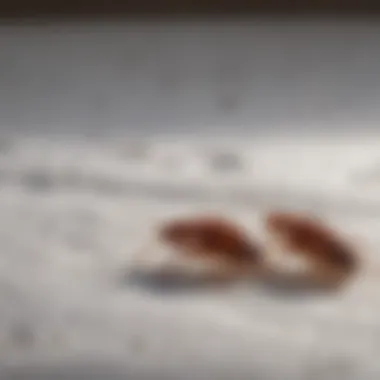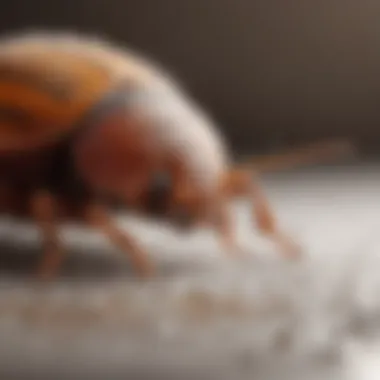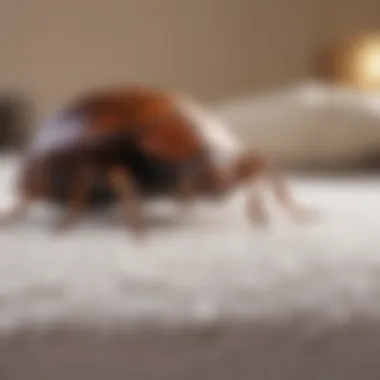Exploring Baking Soda for Effective Bed Bug Control


Intro
Bed bugs are a challenging pest to manage, causing discomfort and distress for many households. With the rising concerns about chemical treatments and their potential side effects, alternatives like baking soda are being explored. Baking soda, or sodium bicarbonate, is often touted as a natural remedy, but how effective is it really? This article delves into the mechanisms of baking soda in bed bug extermination, examines relevant scientific studies, and discusses proper application methods. The content aims to equip readers with a comprehensive understanding of this topic, making it beneficial for both pest control professionals and families facing infestations.
Fascinating Facts About Bed Bugs
Bed bugs are small, wingless insects, scientifically known as Cimex lectularius. They are infamous for their nocturnal feeding habits, often leaving itchy welts on unsuspecting individuals. Let’s look into some unique characteristics and extraordinary abilities of these pests.
Unique Characteristics
- Size and Shape: Adult bed bugs are typically about 4 to 5 mm long and have an oval, flattened shape which allows them to hide easily in tiny crevices.
- Color: They exhibit a reddish-brown color, which can make them hard to spot against wooden or dark surfaces.
- Reproductive Habits: A female can lay hundreds of eggs in her lifetime, leading to swift population growth if left unchecked.
Extraordinary Abilities
- Survival Without Food: Bed bugs can survive several months without a meal, which increases their resilience against eradication efforts.
- Hiding Skills: They can hide in various environments, thanks to their small size, making detection difficult.
Behavior and Habitat
Understanding the behavior and habitat of bed bugs is crucial for effective eradication techniques.
Natural Habitats
Bed bugs commonly reside in homes, hotels, and other lodging facilities, preferring areas close to sleeping humans. They find refuge in mattresses, bedding, and furniture. They are often transported to new locations via luggage or clothing.
Social Structures
Bed bugs are not social insects like ants or bees. However, they do exhibit some degree of aggregation behavior, often clustering together in high-infested areas. Their nocturnal feeding behavior leads them to become active mostly at night when their hosts are asleep.
Recent Scientific Discoveries
Scientific inquiry into pest control methods continues to evolve. Recent studies have shed light on the effectiveness of baking soda as a treatment option.
Latest Research Findings
Several experiments have examined the impact of baking soda on bed bug populations. Research indicates that baking soda can harm bed bugs when it comes into contact with their exoskeletons. The sodium bicarbonate absorbs moisture from the bug, leading to dehydration and eventual death. However, the degree of effectiveness can vary significantly based on environmental factors and application methods.
Breakthroughs in Pest Control
Innovations in pest control strategies are critical as we seek safer alternatives. Researchers are exploring integrated pest management, which combines biological, mechanical, and chemical methods while minimizing adverse effects. Baking soda can fit into this framework as a non-toxic option, but it should not be solely relied upon.
Limitations and Considerations
While baking soda can be a tool in the fight against bed bugs, it is essential to understand its limitations. It may not provide immediate results and may not thoroughly address a severe infestation. Additionally, a multifaceted approach that includes proper sanitation and other control measures is crucial for success.
Ending
In summary, baking soda presents an interesting avenue for bed bug extermination, particularly as folks look for natural solutions. Understanding its mechanisms, applications, and limitations can provide valuable insights for managing these pervasive pests effectively. As the research community continues to explore alternative pest control methods, it is prudent for individuals to remain informed about best practices in integrated pest management.
Preamble to Bed Bugs


Bed bugs have grown increasingly vital to understand within the context of pest management, particularly for homeowners and professionals in pest control. These small, elusive insects can cause significant discomfort and distress. Infestations can happen in any environment, impacting quality of life. Their resilience to many traditional pest control methods complicates eradication efforts. Understanding their biology and habitats aids in effective treatment strategies, making this section essential for creating an informed approach to pest control.
Understanding Bed Bug Biology
Bed bugs, scientifically known as Cimex lectularius, are hematophagous insects, relying on blood for sustenance. Adult bed bugs are approximately 4 to 5 millimeters in length and have a flat, oval shape. Their coloration ranges from light brown to rusty red, depending on their feeding status. A significant aspect of their biology includes the female's ability to lay several eggs daily, leading to rapid population growth under suitable conditions.
Understanding bed bug biology is crucial for effective control measures. They exhibit nocturnal behavior, hiding during daylight in crevices and seams of mattresses, furniture, or within walls. Bed bugs possess a keen sense of smell, which helps locate hosts. They are also known for their resistance to many insecticides, making traditional extermination methods often ineffective.
Common Habitats and Infestation Signs
Bed bugs thrive in various environments, from homes to hotels. Common habitats include:
- Bedrooms: Particularly in and around beds, mattresses, and box springs.
- Upholstered Furniture: Sofas and chairs often harbor bed bugs, especially in seams.
- Cracks and Crevices: Walls and floors can provide hiding spots.
Recognizing infestation signs is essential for early detection:
- Bites: Itchy welts on skin typically occur after bites during the night.
- Exoskeletons: Molted skins may be found near resting areas.
- Fecal Spots: Small, dark spots on bedding or furniture signify presence.
Timely recognition of signs can prevent a minor problem from becoming a major infestation.
Baking Soda: An Overview
Baking soda, scientifically known as sodium bicarbonate, is a common household item with a wide array of uses. Its importance in the context of pest control, particularly against bed bugs, becomes increasingly notable as many seek alternatives to chemical solutions. Understanding baking soda as part of an integrated pest management strategy is crucial. For individuals facing bed bug infestations, exploring an accessible option like baking soda can seem appealing due to its potential efficacy, safety, and lower environmental impact.
Chemical Composition of Baking Soda
Baking soda consists primarily of sodium bicarbonate, a naturally occurring compound. This fine white powder can react with acids, which is a property that many household applications exploit. In pest control, its alkaline nature plays a significant role. When bed bugs come into contact with baking soda, it can disrupt their exoskeleton, potentially leading to dehydration. This interaction is a critical aspect of how baking soda may contribute to bed bug management.
Common Uses in Households
Households utilize baking soda for various practical purposes:
- Baking: It acts as a leavening agent in food preparation.
- Cleaning: Its abrasive qualities make it an excellent scouring powder for surfaces.
- Deodorizing: It can absorb odors effectively in fridges and other spaces.
- Personal Care: Many people use it in toothpaste or as a natural deodorant.
Understanding these characteristics makes baking soda an attractive choice for those looking to manage pests like bed bugs in a less conventional manner. Its multifaceted utility adds depth to its role in households, making it more than just an occasional ingredient.
Mechanisms of Action Against Pests
Understanding how baking soda interacts with pests is crucial for evaluating its efficacy in exterminating bed bugs. The mechanisms of action shed light on how baking soda can disrupt the life cycle of these insects and ultimately reduce their populations. By delving into these mechanisms, one gains insight into the potential benefits, limitations, and considerations for using baking soda in pest control.
How Baking Soda Affects Insects
Baking soda, chemically known as sodium bicarbonate, primarily operates through desiccation. When insects come into contact with baking soda, it can absorb moisture from their bodies. This leads to dehydration, which is fatal for many pests, including bed bugs. The powdery nature of baking soda allows it to adhere to the surface of an insect's exoskeleton, enhancing its ability to absorb moisture.
In addition, baking soda can interfere with the insect's metabolism. When ingested, it can disrupt the digestive system of the insect. This is particularly relevant for bed bugs, which feed on blood. By affecting their ability to process food, baking soda can contribute to their mortality. The dual action of dehydration and metabolic disruption makes baking soda a candidate for consideration in pest management strategies.
Specific Impact on Bed Bugs
The direct impact of baking soda on bed bugs is an area of interest for both researchers and pest control professionals. Bed bugs rely on blood meals for survival, and their biology is closely tied to the ability to feed regularly. When baking soda is present in areas where bed bugs dwell, it can significantly influence their feeding behavior and overall presence.
- Disruption of Feeding: When bed bugs encounter baking soda, they can be discouraged from feeding due to the powder's abrasive nature. This interference can lead to reduced numbers over time.
- Mortality Rates: Laboratory studies have shown that exposure to baking soda can increase mortality rates among bed bugs. The desiccation process, coupled with disruption to their metabolism, can lead to a notable decrease in survival rates.
- Infestation Management: While baking soda may not be a standalone solution, its integration into a broader pest management strategy could enhance overall effectiveness. Used alongside other methods, it may help control bed bug populations without the need for heavy chemical treatments.


Scientific Studies and Evidence
The examination of scientific studies is vital in comprehending the efficacy of baking soda for bed bug extermination. Research provides a factual basis for the claims made regarding this common household substance. Analyzing this research enables homeowners and pest control professionals to make informed decisions about pest management strategies. By understanding the evidence surrounding baking soda, its potential benefits, and limitations can be better appreciated.
Research on Baking Soda Effectiveness
Research indicates that baking soda, or sodium bicarbonate, can damage the exoskeleton of bed bugs. When the powder is applied during an infestation, it can dehydrate the insects by absorbing moisture from their bodies. A study conducted by entomologists observed that the use of baking soda reduced bed bug populations in controlled conditions. These bugs, when exposed to baking soda, showed increased mortality. However, the scale of these studies often limits their real-world applicability. Laboratory results must be taken with caution. The efficiency observed in a controlled environment may not fully translate to actual home settings.
Moreover, the concentration of baking soda used plays a crucial role in its effectiveness. Most studies focus on direct exposure to the insects rather than long-term prevention strategies. While researchers confirm the potential for baking soda to harm bed bugs, they also point out it may not be a standalone solution.
Case Studies and Field Trials
Field trials present a more applicable view of baking soda's efficacy. In various home settings, professionals have utilized baking soda as part of an integrated pest management approach. In these studies, the results typically show variable outcomes. Some cases report satisfactory reductions in bed bug numbers, while others indicate minimal impact.
A particular case in an urban household demonstrated that when baking soda was combined with thorough cleaning practices, the reduction in bed bug sightings significantly improved. It highlighted how combining methods often yields better outcomes than relying on a single approach.
Several limitations arise in these case studies. The variations in environment, the scale of infestations, and the general behavior of bed bugs influence effectiveness. Bed bugs reproduce rapidly and can develop resistance to treatment methods over time, including baking soda. Consequently, one cannot assume that baking soda alone will eliminate an infestation.
Conclusion: While scientific studies and field trials highlight the potential of baking soda, it is clear that its use should be approached carefully. A multifaceted strategy for pest management is advisable. Homeowners should weigh all available information before deciding to rely solely on baking soda for bed bug extermination.
Practical Application Methods
The practical application methods for using baking soda against bed bugs are vital to the effectiveness of this pest control technique. Understanding the correct approach ensures that the efforts yield positive results while minimizing damage to the environment and health. Integrating baking soda into a comprehensive pest management strategy requires diligent attention to detail. It is not about simply scattering baking soda and hoping for the best; rather, it involves specific techniques that allow for the optimal use of this product.
How to Use Baking Soda for Bed Bugs
Using baking soda to combat bed bugs involves a few straightforward methods. First, it is essential to identify the areas where bed bugs are prevalent. Common hiding spots include:
- Mattress seams
- Box springs
- Bed frames
- Furniture crevices
- Baseboards
Once these areas are identified, follow these steps for effective application:
- Prepare the Area: Remove bedding, linens, and any items from the immediate vicinity. This step stops bed bugs from relocating.
- Apply Baking Soda: Sprinkle a generous amount of baking soda directly into the identified spots. Pay close attention to corners and tight spaces where bed bugs tend to hide.
- Leave it for Several Days: Let the baking soda sit for a minimum of three days. This period allows the baking soda to absorb moisture from the pests’ bodies, aiding in their extermination.
- Vacuum Thoroughly: After the waiting period, vacuum all the baking soda and any bed bugs that are affected. Dispose of the vacuum bag immediately to prevent any reinfestation.
These steps not only maximize the effectiveness of baking soda but also ensure that the pests are targeted specifically in their habitats.
Safety Considerations
When employing baking soda as a method for controlling bed bugs, safety remains an important factor. Although baking soda is generally recognized as safe for human use, there are some precautions that should be taken:
- Avoid Inhalation: When applying baking soda, ensure that it does not become airborne. Avoid creating dust clouds.
- Keep Away from Food: Ensure that baking soda application area is free from food particles and utensils to not contaminate anything.
- Check for Allergies: Some individuals may be sensitive or allergic to baking soda. It is wise to perform a patch test or consult a medical professional if allergies are a concern.
- Maintain Cleanliness: After treatment, ensure that the area is cleaned properly to avoid any residual effects of the baking soda. This will also help in maintaining a hygienic environment.
Limitations of Baking Soda
Understanding the limitations of baking soda in bed bug extermination is essential. While it is widely considered a natural remedy, its effectiveness can vary significantly when compared to professional treatments. This section delves into both the inefficacies of baking soda and its potential shortcomings in controlling infestations.
Efficacy vs.
Professional Treatments
Baking soda, or sodium bicarbonate, is often touted as a simple and eco-friendly solution for pest control, particularly for bed bugs. However, its efficacy is not on par with professional extermination methods.


- Limited Impact: Baking soda can impact bed bugs physically, but it does not eliminate eggs, which are the primary avenue for sustaining infestations. Professional exterminators often use chemicals that target both live pests and their eggs.
- Treatment Time: The time required for baking soda to take effect can be lengthy, necessitating repeated applications. In contrast, professional methods typically require less time and deliver immediate results.
- Residual Effect: Many professional treatments come with residual effects that continue to kill or repel pests after the initial application. Baking soda lacks this property, which can lead to re-infestation if not combined with other methods.
- Comprehensive Approach: Professional services offer a multifaceted approach, including inspections, treatments, and follow-ups. Relying solely on baking soda may not address underlying issues leading to infestations.
Possible Resistance among Bed Bugs
One of the critical considerations in using baking soda for bed bug extermination is the potential for resistance. Bed bugs are known for their adaptability and resilience. This adaptability poses challenges for any treatment method, including household remedies like baking soda.
- Historical Resistance: Bed bugs have shown a capacity to develop resistance to various insecticides over time. This phenomenon raises the question of whether they could also adapt to baking soda as a control method.
- Survivor Bias: In small-scale applications, some bed bugs may survive exposure to baking soda. These survivors can reproduce, gradually leading the population to exhibit resistance to the effects of baking soda.
- Need for Integrated Strategies: Given the possibility of resistance, it is crucial to take an integrated pest management approach. Combining baking soda with other methods may enhance effectiveness and reduce the likelihood of resistance developing.
In summary, the potential for resistance among bed bugs emphasizes the need for caution when relying heavily on baking soda. Understanding these limitations allows homeowners to make informed decisions regarding bed bug control.
Alternative Bed Bug Control Methods
The quest to effectively manage bed bug infestations has led to the exploration of various alternative methods beyond traditional pesticide treatments. In this section, we will delve into the importance of considering these alternatives. Employing a multi-faceted approach, including different control methods, increases the chances of successful eradication. It reduces reliance on any single method, which may lose effectiveness due to resistance or other factors.
While baking soda offers a non-toxic solution, understanding other alternatives can provide a fuller strategy. The benefits of exploring these alternative management options include:
- Enhanced Understanding: Knowing various methods can help in assessing what works best in specific situations.
- Flexibility: Different methods can be combined, allowing for adaptability depending on infestation severity.
- Cost-Effectiveness: Some methods might be less costly and easier to implement than hiring pest control services.
Understanding the range of available options empowers homeowners and professionals alike. The following subsections elaborate on three primary alternative approaches to managing bed bug populations.
Chemical Treatments
Chemical treatments remain a common choice for many battling bed bug infestations. Products that are specifically designed for bed bug extermination contain active ingredients like pyrethroids and neonicotinoids. These chemicals interfere with the nervous system of the pests, leading to paralysis and death. When applying these treatments, consider the following:
- Application Precision: Proper targeting of infested areas is crucial; this includes seams, cracks, and under furniture.
- Safety Measures: Follow all safety guidelines to protect both humans and pets. Use appropriate personal protective equipment.
- Residual Effects: Some chemicals provide long-lasting protection, while others act quickly but need frequent reapplication.
The effectiveness of chemical treatments can be diminished due to resistance. Bed bugs have developed tolerances to certain chemicals, making it essential to rotate products with different mechanisms of action periodically.
Physical Removal Techniques
Physical removal techniques involve non-chemical methods, which can be particularly effective when combined with other strategies. These methods, while labor-intensive, can substantially reduce bed bug populations. Key physical techniques include:
- Vacuuming: Carefully vacuuming infested areas can physically remove bed bugs and their eggs. It’s important to dispose of the vacuum contents immediately to prevent re-infestation.
- Heat Treatment: Exposing items to high temperatures can kill bed bugs effectively. Washing bedding and related materials in hot water is a proven method of eradication.
- Encasements: Using bed bug-proof mattress and box spring encasements can trap existing bugs and prevent new ones from entering.
Though physical methods can be effective, they often require persistence and regular maintenance. Failure to adopt a comprehensive strategy may lead to re-infestation.
Integrated Pest Management Approaches
Integrated Pest Management (IPM) is a holistic strategy that combines various control methods, including cultural, biological, physical, and chemical practices. This approach is effective not only in treatment but also in prevention. Key elements of IPM for bed bugs involve:
- Monitoring: Regular inspections can help identify bed bug presence before they become a full-blown infestation.
- Sanitation: Keeping living areas clean and minimizing clutter reduces hiding spots for bed bugs.
- Collaboration with Professionals: Engaging pest control experts can provide insight into the most modern and effective practices available.
Implementing an IPM program can empower homeowners to handle infestations intelligently. The coordinated application of various methods increases effectiveness, reduces chemical dependency, and fosters sustainable pest management practices.
The End and Recommendations
Final Thoughts on Baking Soda Use
Baking soda shows potential as a bed bug treatment. While it is not a silver bullet, it can complement other methods effectively. Its non-toxic nature appeals to those who prefer eco-friendly solutions. However, it is crucial to recognize its limitations. Baking soda may help control smaller infestations but might not suffice for larger ones. Homeowners should consider this option as part of a broader strategy rather than a standalone solution.
Guidelines for Homeowners
Homeowners looking to incorporate baking soda into their pest control efforts should follow these guidelines:
- Assessment of Infestation: Determine the extent of the bed bug problem before application. Baking soda may be helpful in early stages but may not suffice for severe infestations.
- Application Method: Sprinkle baking soda in areas where bed bugs are likely to hide. Focus on corners, crevices, and along baseboards.
- Patience and Persistence: Understand that baking soda requires time to work. Regular application may be necessary to see results.
- Combine with Other Methods: Utilize baking soda alongside other control methods, like vacuuming and steam cleaning, for enhanced effectiveness.
- Ongoing Monitoring: After treatment, keep a close eye on the affected areas to ensure the problem does not return.
In summary, baking soda can offer a useful tool in the fight against bed bugs, but it is essential to approach its use wisely and alongside other pest control techniques.







